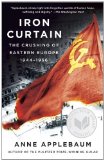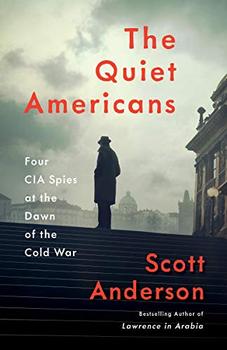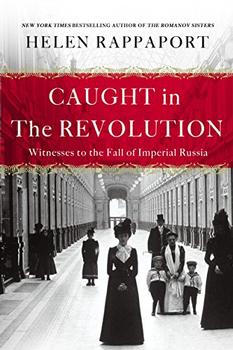Summary | Excerpt | Reviews | Beyond the book | Read-Alikes | Genres & Themes | Author Bio

Critics' Opinion:
Readers' Opinion:
First Published:
Oct 2012, 608 pages
Paperback:
Aug 2013, 640 pages
 Book Reviewed by:
Book Reviewed by:
Kim Kovacs
Buy This Book
In Iron Curtain, Pulitzer Prize-winning author Anne Applebaum provides an in-depth history and analysis of the Soviet Union's systematic takeover of Central Europe after the collapse of Hitler and his Nazi regime. The text covers the brief but remarkably important period from the USSR's WWII victories in 1944 to the failed Hungarian Revolution against Communist rule in 1956.
The author chooses to concentrate on the growth of Communism during these years in three specific Central European countries: East Germany, Poland and Hungary.
"I have chosen these three countries," she writes, "not because they were similar but because there were so very different...Above all, they had different experiences of the war. Germany had, of course, been the main aggressor and then the biggest loser. Poland had fought hard against German occupation and was one of the Allies, although it did not share in the fruits of victory. Hungary had played a role somewhere in between, experimenting with authoritarianism, collaborating with Germany, trying to switch sides and then finding it was too late."
The book is a fascinating study of how an ideology transformed millions of people's lives in a very short period of time, and Applebaum is adept at comparing and contrasting each country's gradual disappearance behind the "Iron Curtain" (a phrase popularized by Winston Churchill referring to the Soviet Union's sphere of influence during the latter half of the 20th century). She demonstrates how the Soviet authorities used techniques perfected in 1930s USSR to subdue the Eastern European populace and gradually transform the nations into Soviet satellites. For example, Applebaum says that between February 1945 and March 1946, "The Red Army brought Moscow-trained secret policemen into every occupied country, put local communists in control of national radio stations, and began dismantling youth groups and other civic organizations. They arrested, murdered, and deported people whom they believed to be anti-Soviet, and they brutally enforced a policy of ethnic cleansing." No organized group was above suspicion including such innocuous organizations as the Boy Scouts and local church groups. Chess clubs, sporting clubs, singing clubs, hiking clubs - all were banned. Between 1945 and 1953, over 150,000 people were incarcerated in prison camps in eastern Germany alone. Hungarian citizens were interred simply because they had German-sounding names.
Some [citizens] were considered suspicious because they appeared to be wealthy or because they owned books. George Bien, then aged sixteen, was arrested along with his father because he owned a shortwave radio. He was interrogated as a spy, forced to confess, and made to sign a thirty-page Russian document, of which he did not understand a single word. Bien eventually wound up in the camps of Kolyma [a Siberian gulag], returning home only in 1955.
People were encouraged to inform on neighbors and even family members. The end result was a constant atmosphere of fear and paranoia that completely discouraged open discussion of Soviet policies.
 Even the arts were forced to conform to Soviet ideals. The authorities insisted that music, poetry, movies, theatre and graphic arts conform to "Socialist Realism." One of the examples Applebaum cites is the story of a huge mural commissioned for a German government building called Aufbau der Republik (Construction of the Republic). The artist, Max Lingner, had to submit numerous designs for approval and eventually had to write an essay of self-criticism when his work failed to please the party bosses. The project, and others like it, ended up badly done "art by committee."
Even the arts were forced to conform to Soviet ideals. The authorities insisted that music, poetry, movies, theatre and graphic arts conform to "Socialist Realism." One of the examples Applebaum cites is the story of a huge mural commissioned for a German government building called Aufbau der Republik (Construction of the Republic). The artist, Max Lingner, had to submit numerous designs for approval and eventually had to write an essay of self-criticism when his work failed to please the party bosses. The project, and others like it, ended up badly done "art by committee."
Although I found Iron Curtain absolutely absorbing, I do have to say that I also found it a very slow read. The information Applebaum presents is quite detailed and complex, and as focus shifts from country to country it becomes necessary to apply a great deal of concentration to make sense of the material being presented. Many times I found myself having to go back a paragraph to determine context. So, while I do recommend the book, readers should be aware going into it that this isn't one of those non-fiction books that reads like a novel; it's definitely closer to a scholarly history book that requires some mental heavy lifting.
Iron Curtain was a finalist for the 2012 National Book Award, and with good reason. The book is an exceptionally interesting and well-researched chronicle of a formative decade in Central Europe's history which will certainly appeal to those interested in post-WWII Europe and the Cold War. Students of modern history will definitely want to add this one to their libraries.
Picture from marxists.org
Listen to an interview with Anne Applebaum about Iron Curtain on NPR's Fresh Air.
![]() This review was originally published in The BookBrowse Review in January 2013, and has been updated for the
September 2013 edition.
Click here to go to this issue.
This review was originally published in The BookBrowse Review in January 2013, and has been updated for the
September 2013 edition.
Click here to go to this issue.

If you liked Iron Curtain, try these:

by Scott Anderson
Published 2021
From the bestselling author of Lawrence in Arabia, a gripping history of the early years of the Cold War, the CIA's covert battles against communism, and the tragic consequences which still affect America and the world today.

by Helen Rappaport
Published 2018
From the bestselling author of The Romanov Sisters, Caught in the Revolution is Helen Rappaport's masterful telling of the outbreak of the Russian Revolution through eye-witness accounts left by foreign nationals who saw the drama unfold.





The House on Biscayne Bay
by Chanel Cleeton
As death stalks a gothic mansion in Miami, the lives of two women intertwine as the past and present collide.

The Flower Sisters
by Michelle Collins Anderson
From the new Fannie Flagg of the Ozarks, a richly-woven story of family, forgiveness, and reinvention.

The Funeral Cryer by Wenyan Lu
Debut novelist Wenyan Lu brings us this witty yet profound story about one woman's midlife reawakening in contemporary rural China.
Your guide toexceptional books
BookBrowse seeks out and recommends the best in contemporary fiction and nonfiction—books that not only engage and entertain but also deepen our understanding of ourselves and the world around us.